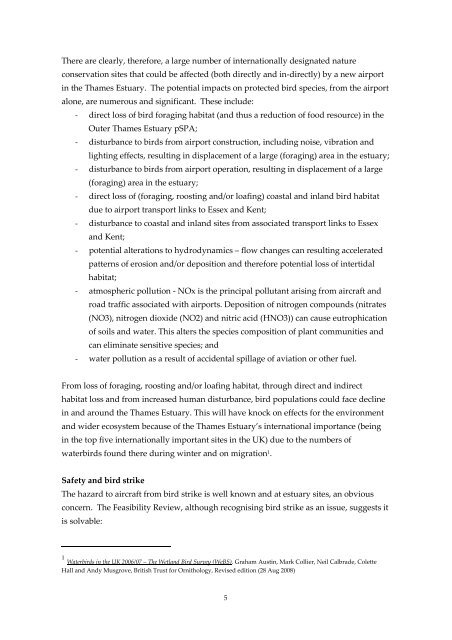1. Ecological objections - London
1. Ecological objections - London
1. Ecological objections - London
You also want an ePaper? Increase the reach of your titles
YUMPU automatically turns print PDFs into web optimized ePapers that Google loves.
There are clearly, therefore, a large number of internationally designated nature<br />
conservation sites that could be affected (both directly and in-directly) by a new airport<br />
in the Thames Estuary. The potential impacts on protected bird species, from the airport<br />
alone, are numerous and significant. These include:<br />
- direct loss of bird foraging habitat (and thus a reduction of food resource) in the<br />
Outer Thames Estuary pSPA;<br />
- disturbance to birds from airport construction, including noise, vibration and<br />
lighting effects, resulting in displacement of a large (foraging) area in the estuary;<br />
- disturbance to birds from airport operation, resulting in displacement of a large<br />
(foraging) area in the estuary;<br />
- direct loss of (foraging, roosting and/or loafing) coastal and inland bird habitat<br />
due to airport transport links to Essex and Kent;<br />
- disturbance to coastal and inland sites from associated transport links to Essex<br />
and Kent;<br />
- potential alterations to hydrodynamics – flow changes can resulting accelerated<br />
patterns of erosion and/or deposition and therefore potential loss of intertidal<br />
habitat;<br />
- atmospheric pollution - NOx is the principal pollutant arising from aircraft and<br />
road traffic associated with airports. Deposition of nitrogen compounds (nitrates<br />
(NO3), nitrogen dioxide (NO2) and nitric acid (HNO3)) can cause eutrophication<br />
of soils and water. This alters the species composition of plant communities and<br />
can eliminate sensitive species; and<br />
- water pollution as a result of accidental spillage of aviation or other fuel.<br />
From loss of foraging, roosting and/or loafing habitat, through direct and indirect<br />
habitat loss and from increased human disturbance, bird populations could face decline<br />
in and around the Thames Estuary. This will have knock on effects for the environment<br />
and wider ecosystem because of the Thames Estuary’s international importance (being<br />
in the top five internationally important sites in the UK) due to the numbers of<br />
waterbirds found there during winter and on migration 1 .<br />
Safety and bird strike<br />
The hazard to aircraft from bird strike is well known and at estuary sites, an obvious<br />
concern. The Feasibility Review, although recognising bird strike as an issue, suggests it<br />
is solvable:<br />
1 Waterbirds in the UK 2006/07 – The Wetland Bird Survey (WeBS), Graham Austin, Mark Collier, Neil Calbrade, Colette<br />
Hall and Andy Musgrove, British Trust for Ornithology, Revised edition (28 Aug 2008)<br />
5
















